The Sufficient-Component Cause Model
In 1976 Ken Rothman, who is a member of the epidemiology faculty at BUSPH, proposed a conceptual model of causation known as the "sufficient-component cause model" in an attempt to provide a practical view of causation which also had a sound theoretical basis. The model has similarities to the "web of causation" theory described above, but is more developed in the sense that it simultaneously provides a general model for the conditions necessary to cause (and prevent) disease in a single individual and for the epidemiological study of the causes of disease among groups of individuals.
A Sufficient Cause
Rothman recognized that disease outcomes have multiple contributing determinants that may act together to produce a given instance of disease. For example, exposure to someone who has TB does not necessarily result in the occurrence of TB. Moreover, the set of determinants that produce TB in one individual may not be the same set of conditions that were responsible for the occurrence of TB in others.
Rothman defined a sufficient cause as "...a complete causal mechanism" that "inevitably produces disease." Consequently, a "sufficient cause" is not a single factor, but a minimum set of factors and circumstances that, if present in a given individual, will produce the disease. Aschengrau and Seage use the example of causation of AIDS. A sufficient cause for AIDS might consist of the following components:
- exposure to an individual with HIV
- repeatedly engaging in risky sexual behavior with that individual
- absence of antiretroviral drugs that reduce viral load of HIV
The pie chart below might be used to represent the sufficient cause model for this scenario.
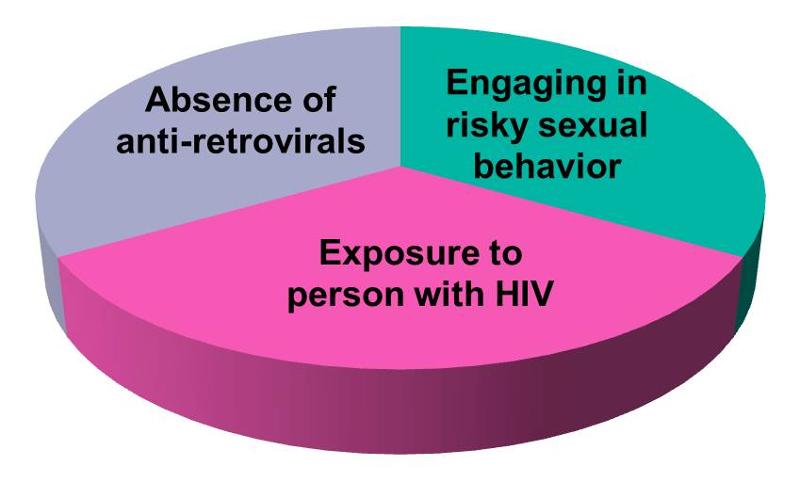
The model suggests that the presence of these three component causes is sufficient to produce AIDS in this individual. Note further if any one of these components were absent, AIDS would not occur. Hence, Rothman's assertion that a cause is an event, condition, or characteristic without which the disease would not have occurred. Note that the sufficient cause illustrated here is only one manner in which AIDS could occur. Different individuals will have different sets of individual components that combine to produce a sufficient cause (i.e., a case of AIDS). If one were to apply the sufficient-component cause model to tuberculosis (TB), one possible cause might be represented by the pie chart below.

This sufficient cause may have applied to many of the people who developed TB in the United Kingdom during the 19th and 20th century. The line graph below shows the annual mortality from TB per 100,000 population from 1850 to 1960.
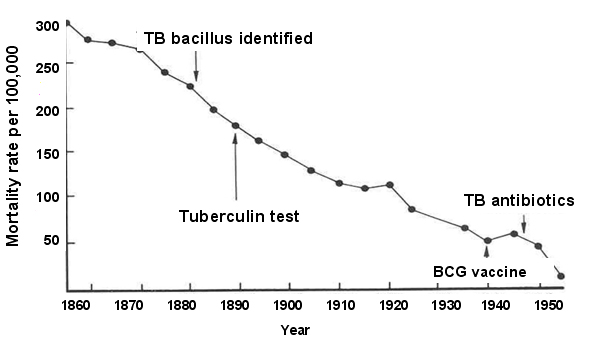
During this time span the introduction of "the hygienic idea" and the subsequent development of public health initiatives led to gradual improvements in living conditions, including less crowding, better ventilation, and better nutrition. The decreased prevalence of these components is likely to have been responsible for the steady decline in TB mortality seen during this period. Note, however, the two points on the line graph that correspond to World War I and World War II when there are temporary increases in TB mortality. It is well known that the wars had a widespread impact on the population and that nutrition suffered and people were sometimes seeking shelter in bomb shelters that were poorly ventilated and crowded. The sufficient-component model to the left offers a coherent explanation for the cause of TB mortality in a large proportion of the population during this period, and it also explains the steady decline punctuated with the temporary increases seen during war time.
There may, however, be many sufficient causes of TB which may differ in their components, although some components might be shared among different sufficient causes. Consider, for example, the two sufficient causes below.
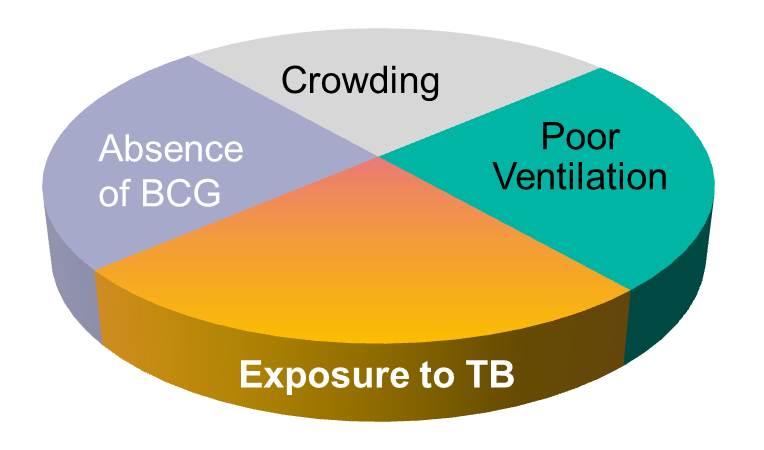
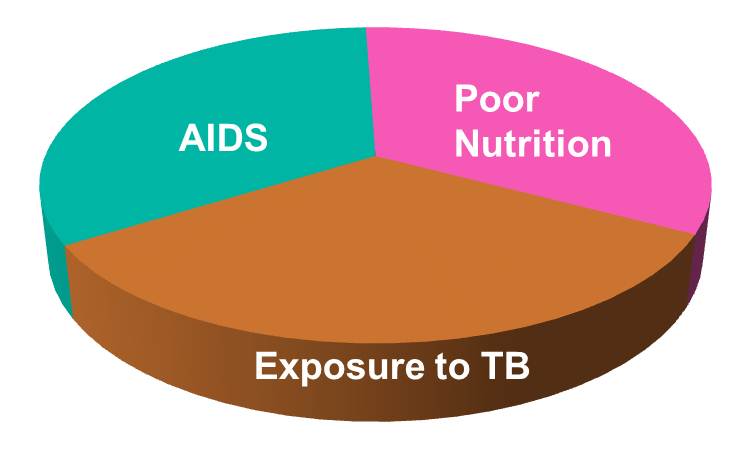
Among the three sufficient causes of TB illustrated above, there are both similarities and differences in the composition of the components. They also differ in the number of components. For example, an individual with AIDS and poor nutrition would be severely immunocompromised, so the only component needed to complete the causation of TB would be exposure to the TB bacillus.
The figure below outlines many of the key factors and events in the transition of a normal cell to a cancerous cell. A variety of environmental factors (chemical carcinogens, radiation, viruses, etc.) might cause damage to the cell's DNA. There are DNA repair mechanisms, but these are not always successful in repairing damage; in addition, some people have inherited defects in DNA repair mechanisms. If repair is unsuccessful, a mutation may result, and if the mutation occurs in a proto-oncogene or an anti-oncogene, regulation of cell replication may be lost. If a third mutation were to occur, damaging apoptosis, then the final component cause is in place, and the cell will be cancerous.
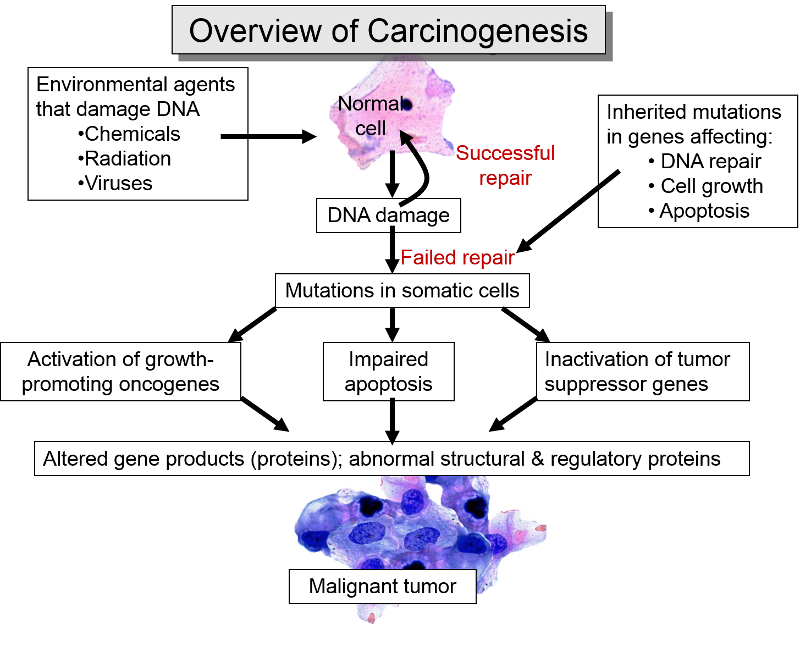
The image below illustrates a sufficient cause that reflects these events. Note also that there may be a period of time before the cancer is detectable or produces symptoms.
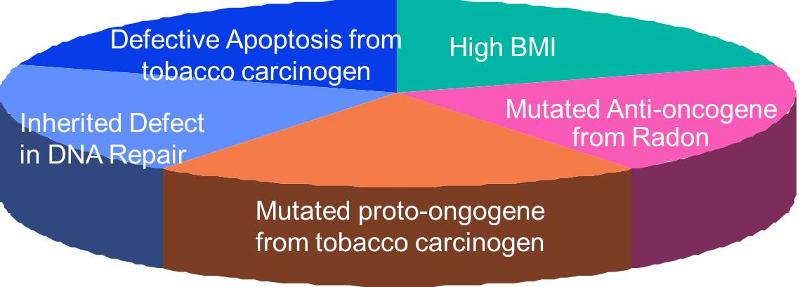
Necessary Components
Note that in the three sufficient causes of TB above, exposure to TB is present in all three because it must be present for a TB infection to occur. On the other hand, TB exposure by itself will not result in infection unless other components are also present. In other words exposure to the TB bacillus is a necessary, but not solely sufficient component. However, many, if not most, sufficient causes do not have a necessary component.
Features of the Sufficient-Component Cause Model
Aschengrau and Seage point out some of the key features of the sufficient-component cause model:
- A cause is not a single component, but a minimal set of conditions or events that inevitably produces the outcome.
- Each component in a sufficient cause is called a component cause, and epidemiologists tend to refer to the components as "causes" because the outcome will not occur by that pathway if any one of the components is missing (or prevented) within a given sufficient cause model. Consequently, it is not necessary to identify all of the component causes in order to prevent the disease outcome.
- There may be a number of sufficient causes for a given disease or outcome.
- A component cause that must be present in every sufficient cause of a given outcome is referred to as a necessary cause. For example, HIV exposure is necessary for AIDS to occur, and TB exposure is necessary for TB infection to occur.
- The completion of a sufficient cause is synonymous with the biologic occurrence of the outcome, e.g., the transition to a malignant cancer within a single cell marks the biologic onset of the cancer.
- The components of a sufficient cause do not need to act simultaneously; they can act at different times. For example, a mutation in a proto-oncogene in a prostate cell may promote cell replication at one point in time, and it may be some time later when another mutation diminishes the function of an anti-oncogene in the same cell. Thus, each component cause may have a different induction period
 (the interval between the exposure's presence and disease onset). In contrast, the latent period is the interval between disease onset and the clinical detection of disease, either by screening or as a result of symptoms and diagnostic work up. In the context of screening tests the latent period is referred to as the "detectable pre-clinical phase." In the context of infectious disease, it is the time between initial infection and the first appearance of symptoms.
(the interval between the exposure's presence and disease onset). In contrast, the latent period is the interval between disease onset and the clinical detection of disease, either by screening or as a result of symptoms and diagnostic work up. In the context of screening tests the latent period is referred to as the "detectable pre-clinical phase." In the context of infectious disease, it is the time between initial infection and the first appearance of symptoms.


